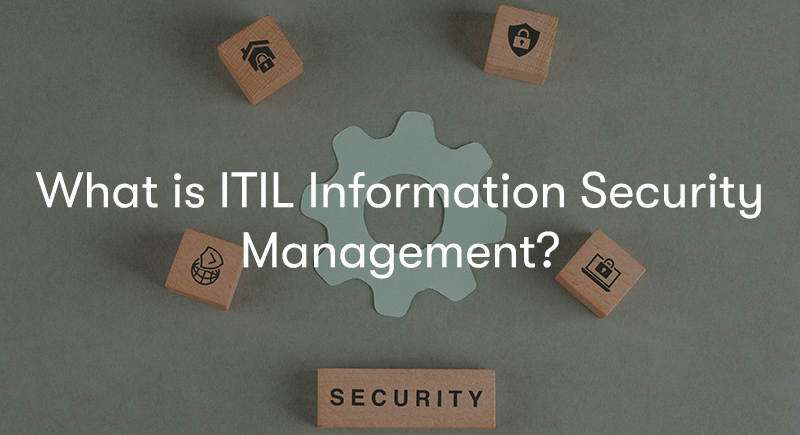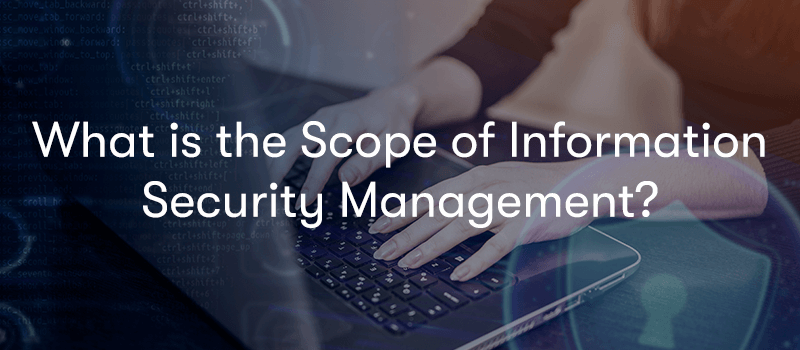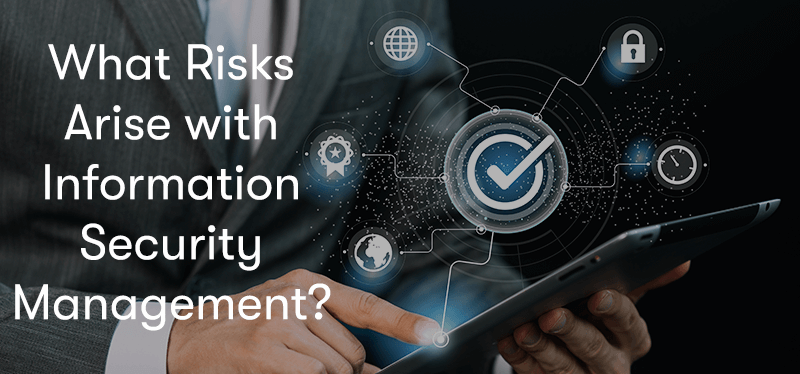The core philosophy of ITIL revolves around the concept of providing IT services as a means to support business objectives. It emphasises the importance of understanding and meeting customer requirements, optimising service quality, and continually improving service delivery.
ITIL Information Security Management is a specific domain within the ITIL framework that focuses on ensuring the confidentiality, integrity, and availability of information assets within an organisation. With the increasing reliance on technology and the growing threat landscape, organisations need robust information security practices to protect sensitive data, prevent unauthorised access, and mitigate risks.
ITIL Information Security Management
Information Security Management is one of ITIL4’s 34 practices. Information Security Management provides organisations with a structured and systematic approach to identifying, assessing, and managing information security risks. It involves establishing policies, implementing controls, and conducting regular audits to ensure the confidentiality, integrity, and availability of information assets.
ITIL Information Security Management also plays a crucial role in regulatory compliance. Many industries have specific regulations and standards governing the protection of sensitive data, such as personally identifiable information (PII) or financial information. By following the ITIL framework, organisations can ensure they meet these regulatory requirements and avoid potential legal and financial repercussions.
The ultimate goal of ITIL Information Security Management is to protect sensitive information, maintain business continuity, and uphold the trust and confidence of customers and stakeholders. By implementing security controls, organisations can minimise the likelihood and impact of security incidents, such as data breaches or unauthorised access.
PeopleCert have recently released a course called ITIL® 4 Practitioner: Information Security Management. It is a one-day course that covers the practice in full.
What is ITIL Information Security Management?

The ITIL4 definition of this practice is to protect information that is vital to the organisation to perform its business. Information security management implements preventions and precautions of breaches to reduce the risk of confidential data being leaked. Along with the integrity on the information, the security of the data, the data must be readily accessible to authorised parties when necessary.
What is the Objective of Information Security Management in ITIL?

The goal of ITIL Information Security Management is to establish a systematic and proactive approach to managing information security. It provides guidance on defining and implementing security policies, assessing risks, conducting security audits, and implementing controls to safeguard information assets. By adopting ITIL Information Security Management practices, organisations can effectively manage security incidents, minimise the impact of security breaches, and maintain the trust and confidence of their stakeholders.
Protect Information Assets: The primary objective of ITIL 4 Information Security Management is to protect the confidentiality, integrity, and availability of information assets within an organisation. This includes sensitive data, intellectual property, customer information, and other critical information resources. Some objectives of ITIL 4 Information Security Management are:
Identify and Assess Security Risks
ITIL 4 Information Security Management aims to identify, assess, and understand the risks associated with information security. This involves conducting risk assessments, vulnerability assessments, and business impact analysis to determine the potential threats and vulnerabilities that could compromise information assets.
Establish Security Policies and Standards
ITIL 4 Information Security Management helps in defining and implementing comprehensive security policies and standards. These policies outline the organisation's approach to information security, set clear expectations, and establish a framework for implementing security controls and measures.
Implement Security Controls
ITIL 4 Information Security Management focuses on implementing a set of technical, physical, and administrative controls to mitigate information security risks. These controls may include access controls, encryption mechanisms, intrusion detection systems, firewalls, security awareness programs, and incident response procedures.
Manage Security Incidents
ITIL 4 Information Security Management aims to establish effective processes and procedures for detecting, responding to, and resolving security incidents. This includes establishing incident response teams, defining escalation procedures, and implementing incident management practices to minimise the impact of security breaches and ensure a timely and effective response.
Ensure Regulatory Compliance
ITIL 4 Information Security Management helps organisations achieve and maintain compliance with relevant legal, regulatory, and contractual requirements. This includes compliance with data protection regulations, industry-specific standards, and customer-specific security requirements.
Foster Security Awareness and Culture
ITIL 4 Information Security Management promotes a culture of security within the organisation. It emphasises the importance of security awareness training programs, regular communication, and promoting a security-conscious mindset among employees and stakeholders.
Continual Improvement
ITIL 4 Information Security Management follows the principle of continual improvement. It aims to regularly assess the effectiveness of information security measures, identify areas for enhancement, and implement improvements to strengthen the overall security posture of the organisation.
What is the Scope of Information Security Management?

The scope of ITIL 4 Information Security Management encompasses several key areas within an organisation. Here are the main aspects covered by ITIL 4 Information Security Management:
Information Assets
ITIL 4 Information Security Management focuses on protecting the organisation's information assets. This includes all forms of sensitive information, such as customer data, intellectual property, financial records, and other critical information resources that need to be safeguarded.
IT Infrastructure
ITIL 4 Information Security Management considers the security of the organisation's IT infrastructure. This includes servers, networks, databases, applications, and other technology components that store, process, or transmit sensitive information.
Systems and Applications
ITIL 4 Information Security Management addresses the security of systems and applications within the organisation. It ensures that appropriate security controls and measures are in place to protect against unauthorised access, data breaches, and other security risks.
Security Policies and Standards
ITIL 4 Information Security Management establishes security policies and standards that guide the organisation's approach to information security. This includes defining acceptable use policies, data classification policies, access control policies, and other guidelines that ensure consistent and effective security practices.
Security Controls
ITIL 4 Information Security Management encompasses the implementation and management of security controls. This includes technical controls such as firewalls, intrusion detection systems, encryption mechanisms, and authentication mechanisms, as well as physical controls and administrative controls.
Security Incident Management
ITIL 4 Information Security Management involves the establishment of processes and procedures for handling security incidents. This includes incident detection, reporting, investigation, containment, and resolution, with a focus on minimising the impact of security breaches and restoring normal operations as quickly as possible.
Risk Management
ITIL 4 Information Security Management incorporates risk management practices. It involves identifying and assessing security risks, conducting risk analysis and vulnerability assessments, and implementing appropriate controls and countermeasures to mitigate the identified risks.
Compliance
ITIL 4 Information Security Management ensures that the organisation complies with relevant legal, regulatory, and contractual requirements related to information security. This includes compliance with data protection regulations, industry-specific standards, and customer-specific security requirements.
Security Awareness and Training
ITIL 4 Information Security Management promotes security awareness and training programs to educate employees about information security best practices, policies, and procedures. It aims to foster a security-conscious culture within the organisation and ensure that individuals understand their roles and responsibilities in maintaining information security.
What Are the Benefits of Information Security Management?

Implementing ITIL Information Security Management practices can bring several benefits to organisations, including:
Enhanced Information Security
By following the ITIL Information Security Management framework, organisations can systematically address information security risks, implement effective controls, and improve their overall security posture.
Compliance with Regulations
ITIL Information Security Management assists organisations in meeting legal, regulatory, and contractual requirements related to information security, such as the General Data Protection Regulation (GDPR), Payment Card Industry Data Security Standard (PCI DSS), and other industry-specific regulations.
Improved Incident Response
The framework helps establish structured processes for identifying, reporting, and responding to security incidents, allowing organisations to minimise the impact of breaches and mitigate potential damage.
Increased Customer Trust
Implementing ITIL Information Security Management practices demonstrates a commitment to protecting customer data and confidential information, fostering trust and confidence among stakeholders.
Cost Efficiency
By proactively managing information security risks, organisations can reduce the potential financial and reputational impact of security incidents, as well as avoid costly remediation measures.
Continual Improvement
The ITIL principle of continual service improvement applies to information security management as well. By regularly assessing and improving security practices, organisations can adapt to new threats, technologies, and business requirements.
What Concepts Are Important to Understand?
By grasping these concepts, organisations can effectively implement ITIL 4 Information Security Management practices, enhance their information security capabilities, and mitigate risks to their information assets. Here are the key concepts:
Information Security Governance
Information Security Governance refers to the framework and processes in place to ensure the organisation's information security objectives are aligned with its overall business goals and strategies. It involves establishing accountability, defining roles and responsibilities, and implementing decision-making processes related to information security.
Risk Management
Risk Management is a fundamental concept in ITIL 4 Information Security Management. It involves identifying, assessing, and managing risks to information assets. This includes conducting risk assessments, vulnerability assessments, and business impact analysis to determine potential threats and vulnerabilities and implementing appropriate controls to mitigate or manage these risks.
Security Controls
Security Controls are measures implemented to protect information assets and mitigate security risks. They can be technical, physical, or administrative controls. Examples of security controls include access controls, encryption mechanisms, firewalls, intrusion detection systems, antivirus software, and security awareness programs. Understanding different types of security controls and their implementation is crucial in ensuring information security.
Security Incident Management
Security Incident Management encompasses processes and procedures for detecting, responding to, and resolving security incidents. It involves establishing incident response teams, defining escalation procedures, and implementing incident management practices to minimise the impact of security breaches and ensure timely and effective response and recovery.
Security Awareness and Training
Security Awareness and Training involve educating employees about information security best practices, policies, and procedures. It aims to foster a security-conscious culture within the organisation, ensuring individuals understand their roles and responsibilities in maintaining information security.
Compliance and Regulatory Requirements
Compliance with relevant legal, regulatory, and contractual requirements is a crucial aspect of ITIL 4 Information Security Management. This includes complying with data protection regulations, industry-specific standards, and customer-specific security requirements. Understanding the compliance landscape and ensuring adherence to applicable requirements is essential.
Continual Improvement
Continual Improvement is a core principle of ITIL 4, and it applies to Information Security Management as well. It emphasises the importance of regularly assessing and improving security practices to adapt to new threats, technologies, and business requirements. Continual Improvement involves monitoring security performance, identifying areas for enhancement, and implementing changes to strengthen the organisation's overall security posture.
What Are the Process Activities for ITIL Information Security Management?

The ITIL Information Security Management Practice incorporates several processes that help organisations effectively manage and maintain the security of their information assets. These processes include:
Information Security Policy
Establishing an overarching policy that outlines the organisation's commitment to information security, defines roles and responsibilities, and sets the direction for implementing security controls.
A policy defines what must be done and why, also what the consequences are of non-compliance.
Risk Management
Conducting risk assessments to identify potential threats, vulnerabilities, and impacts on information assets. Risk management involves analysing risks, evaluating their significance, and implementing appropriate controls to mitigate or manage them.
Security Controls
Implementing a set of technical, physical, and administrative controls to protect information assets. These controls include access controls, encryption, firewalls, intrusion detection systems, antivirus software, and security awareness programs.
Security Incident Management
Establishing processes for detecting, responding to, and resolving security incidents. This includes incident reporting, investigation, containment, and recovery to minimise the impact of security breaches.
Security Audits
Conducting regular audits to assess compliance with security policies, controls, and regulatory requirements. Audits help identify vulnerabilities, gaps in security measures, and areas for improvement.
Security Awareness and Training
Educating employees about information security best practices, policies, and procedures through training programs and awareness campaigns. This helps foster a security-conscious culture within the organisation.
What Challenges Might You Face?
Implementing ITIL 4 Information Security Management can bring about various challenges. Some common challenges organisations may face include:
Organisational Resistance
Resistance to change can be a significant challenge when implementing ITIL 4 Information Security Management. Some employees may be resistant to adopting new policies, processes, and controls, which can hinder the successful implementation of information security practices.
Lack of Awareness and Training
Insufficient awareness and training programs can impede the effective implementation of ITIL 4 Information Security Management. Without proper education and understanding of information security principles and practices, employees may not fully comprehend their roles and responsibilities or the importance of complying with security measures.
Resource Constraints
Organisations may face resource constraints, such as limited budget, time, and expertise, when implementing ITIL 4 Information Security Management. It may require investments in technology, security tools, training, and hiring skilled personnel, which can pose challenges for organisations with limited resources.
Complexity and Scalability
ITIL 4 Information Security Management can be complex, especially in large organisations or those with diverse IT environments. Scaling security practices across the organisation, ensuring consistency, and integrating security controls with existing processes and systems can be challenging.
Balancing Security and Business Needs
Striking a balance between implementing robust security measures and meeting business requirements can be a challenge. Security measures should not impede business operations or hinder productivity. Finding the right balance between security and business needs is crucial for successful implementation.
Evolving Threat Landscape
The ever-evolving nature of cybersecurity threats presents an ongoing challenge for ITIL 4 Information Security Management. New types of threats, vulnerabilities, and attack techniques emerge regularly, requiring organisations to continuously update and adapt their security controls to mitigate these risks effectively.
Compliance and Regulatory Requirements
Meeting compliance and regulatory requirements can be complex and challenging, especially in highly regulated industries. Keeping up with changing regulations, understanding their implications, and implementing appropriate controls to ensure compliance require continuous effort and monitoring.
Communication and Stakeholder Engagement
Effective communication and stakeholder engagement are vital for the successful implementation of ITIL 4 Information Security Management. Gaining buy-in from stakeholders, including senior management, IT teams, and employees, and ensuring clear and consistent communication about the importance of information security can be challenging.
Overcoming these challenges requires commitment, support from leadership, adequate resources, ongoing training and awareness programs, and a systematic approach to addressing obstacles as they arise. It is important to recognise that implementing ITIL 4 Information Security Management is an ongoing process of improvement and adaptation to the changing security landscape.
What Risks Arise with Information Security Management?

While implementing ITIL 4 Information Security Management can enhance an organisation's security posture, there are potential security risks that can arise. Some of the risks include:
Insider Threats
Insider threats refer to security risks originating from within the organisation. This can include employees, contractors, or business partners who intentionally or accidentally misuse or disclose sensitive information, bypass security controls, or exploit vulnerabilities.
External Threats
External threats encompass a wide range of risks posed by malicious actors outside the organisation. These threats can include hacking attempts, malware infections, social engineering attacks, phishing, ransomware, and other forms of cyberattacks targeting the organisation's information assets.
Inadequate Access Controls
Weak access controls can lead to unauthorised access to sensitive information, compromising its confidentiality and integrity. Insufficiently enforced access policies, weak passwords, improper user provisioning, and inadequate identity and access management practices can increase the risk of unauthorised access.
Data Breaches and Loss
Inadequate data protection measures can result in data breaches or loss of sensitive information. This can occur due to vulnerabilities in systems and applications, insufficient encryption or data protection mechanisms, or improper handling and disposal of data.
Lack of Patch Management
Failure to apply security patches and updates to systems and software can leave vulnerabilities unaddressed, making them susceptible to exploitation. Outdated or unpatched software may contain known vulnerabilities that attackers can exploit to gain unauthorised access or disrupt operations.
Insecure Third-Party Relationships
Organisations often rely on third-party vendors, suppliers, or service providers. However, inadequate security controls in these relationships can introduce risks. Insufficient due diligence, weak contractual agreements, or improper handling of data by third parties can result in security breaches and compromise sensitive information.
Inadequate Incident Response
Ineffective incident response processes and procedures can delay the detection, containment, and resolution of security incidents. Without a well-defined and tested incident response plan, organisations may struggle to respond promptly, increasing the potential damage caused by security incidents.
Regulatory Non-Compliance
Non-compliance with relevant laws, regulations, and industry standards can lead to legal and financial consequences. Failure to implement appropriate security controls, protect customer data, or report security incidents as required by regulations can result in penalties and reputational damage.
To mitigate these risks, organisations implementing ITIL 4 Information Security Management should conduct thorough risk assessments, implement robust security controls, educate employees about security best practices, monitor systems for potential threats, and establish effective incident response procedures. Regular security audits, vulnerability assessments, and ongoing training and awareness programs are also essential to ensure ongoing protection against security risks.
Final Notes On Information Security Management and ITIL
Information Security Management is a framework that provides guidance and best practices for managing information security within an organisation. It focuses on establishing and maintaining effective security controls to protect the confidentiality, integrity, and availability of information assets.
The key components of ITIL Information Security Management include risk management, policy development, security awareness and training, incident management, and compliance monitoring. It emphasises a proactive approach to security, promoting the identification and mitigation of risks before they become major issues. This involves conducting risk assessments, implementing appropriate controls, and continually monitoring and reviewing security measures.
It helps organisations reduce the risk of security breaches and incidents, safeguarding sensitive information and maintaining business continuity. It enables organisations to comply with legal, regulatory, and contractual requirements related to information security.
Furthermore, ITIL Information Security Management promotes collaboration and communication between various stakeholders, including IT teams, management, and employees. This facilitates a shared understanding of security responsibilities and enhances the organisation's ability to respond to security incidents.
In summary, ITIL Information Security Management provides a comprehensive framework for managing information security. By implementing its principles and practices, organisations can enhance their security posture, reduce risks, and ensure the protection of critical information assets.
If you would like to learn more about ITIL4 Information Security Management, please check out our ITIL® 4 Practitioner: Information Security Management 1 day course. Please note ITIL 4 Foundation is a prerequisite for this course.




